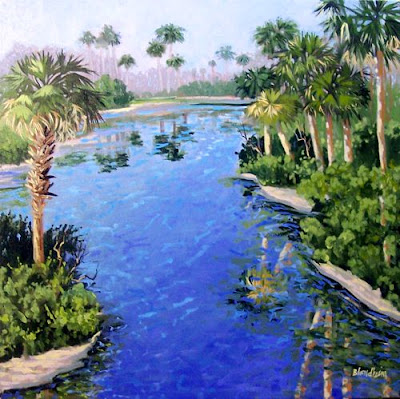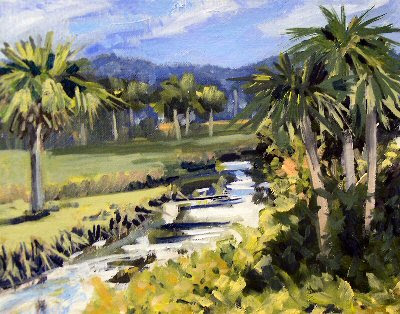
River Palms
24x24 inches
oil on canvas
champagne silver frame
1800.00
Purchase HERE
Painters Tip
Making Adjustments in Your Journey
About 15 years ago I started painting out on location. I had read all about the Impressionists, and the California Painters in art school and it seemed like what I should be doing. I've always been a studio painter since about the age of eight and I have always enjoyed the still life.
I spent about five years doing nothing but alla prima location painting. In my heart, I knew that I was a better studio painter than location painter but the location work is all the rage among landscape painters so I kept on.
I became more and more dissatisfied with my alla prima work, feeling that there was something missing. The slap-dash rough look to it and the simplified compositions were lacking in depth and complexity. Alla Prima, by necessity is painterly and simplified because of the time constraints and the sun's changes over a period of time.
I started doing some studio work again and I'm glad I did. I have gradually gone back to studio work, going out on location to paint studies once or twice a week and on my travels. I still do a few paint outs each year because I love seeing my friends and painting in such beautiful places. I will often use the paintings I do on location to craft larger more complex paintings in studio.
I know that getting off the plein air band wagon is risky because it is so popular, but I need to paint well and in a satisfying way. I can't worry about that. Going out to do studies and doing paint outs, keeps my observation skills intact and helps me to do better studio work. I now have the best of both worlds and much better paintings.
Most importantly, I now really enjoy my time on location because I don't have the pressure of calling myself a plein air painter. I prefer to call myself a landscape painter. My plein air time is so much more satisfying now. I no longer get involved with the politics of plein air. Instead, I just enjoy painting at the places I love.
My point here after all of this rambling is that sometimes we need to make a change in our painting goals in order to grow and improve. Sometime these decisions may be unpopular with other artists or even your patrons. You may feel a lot of pressure from others to stay where you are in your paintings. Don't let them deter you from doing what you must to find the right fit for your work. The changes I made have paid off very well indeed.
































